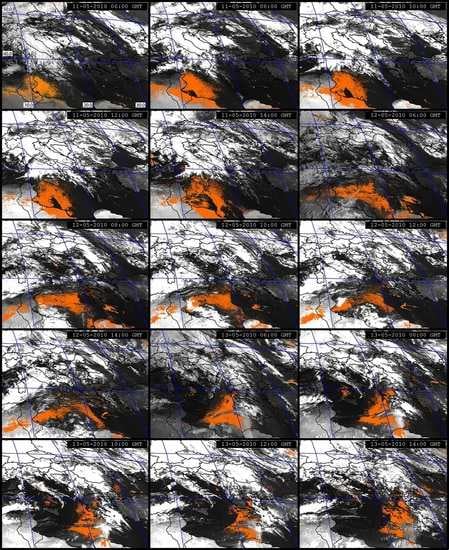An Enhanced Satellite-Based Algorithm for Detecting and Tracking Dust Outbreaks by Means of SEVIRI Data
Abstract
:1. Introduction
2. Background
3. Methods
3.1. Standard RSTDUST Algorithm
3.2. Enhanced RSTDUST Algorithm (eRSTDUST)
Implementation on MSG-SEVIRI Data
4. Validation Products
- NASA Terra and Aqua-MODIS AOD at 550 nm products used here (referring to same time and hour of processed SEVIRI data) belong to the MOD04_L2 and MYD04_L2 datasets of the Level-1 & Atmosphere Archive and Distribution System (LAADS). These aerosol products, with a spatial resolution of 10 km × 10 km (at nadir), are based on MODIS radiances analysed by means of two different algorithms: one for the deep ocean areas [66] and the other for dark targets (e.g., vegetated regions; dark soils; [67,68]). Independent analyses showed that the expected error in MODIS AOD at 550 nm is in the order of ± (0.05τ + 0.03) over oceans and ± (0.15τ + 0.05) over land regions [69], where τ is the aerosol optical depth. Since the traditional MODIS algorithm generally fails in retrieving the AOD over bright land areas [70], the MODIS Deep Blue AOD daily products are commonly used over arid and semi-arid regions (e.g., [71]). These products, which are generated by using the MODIS blue channel radiances, where the contribution from the surface is relatively low, provide information about dust aerosols residing close to the ground [72]. In this study, we exploit information provided by the MODIS Deep Blue AOD daily maps (generated from Giovanni MODIS data system) belonging to collection 5.1 (having the same spatial resolution as above) to assess the identification of airborne dust over North Africa. However, it is important to stress that we do not use the aforementioned aerosol products to perform a quantitative pixel-by pixel assessment of dust detections from space. On the other hand, we only investigate the possible spatial agreement between dusty areas identified by our algorithm and regions characterized by significant values of AOD (which does not require the resampling of SEVIRI data to fit with the lower spatial resolution of analysed MODIS aerosol products).
- CALIOP is a two-wavelength polarization lidar providing high-resolution vertical profiles of clouds and aerosols in the troposphere and lower stratosphere [73,74]. This lidar is the primary instrument of CALIPSO (Cloud-Aerosol Lidar and Infrared Pathfinder Satellite Observations), which is part of the NASA “A-train” constellation [73,74,75]. The Level 1 CALIOP data products include calibrated and geo-located profiles of the total backscatter signal at 532 nm and 1064 nm, as well as of the perpendicular component of the 532 nm backscatter return [72]. The CALIOP Level 2 products analyse aerosol and cloud layers, respectively, classifying them into different types and the ice/water phase [74,76]. CALIOP observations have been widely exploited to assess the presence of desert dust aerosols inferred by AOD products at 532 nm and 1064 nm (e.g., [51,77]).
- AERONET is a global network of ground-based sun photometers measuring the atmospheric aerosol properties and providing globally distributed observations of AOD (at 340, 380, 440, 500, 675, 870, 940, and 1020 nm) inversion products and precipitable water in different aerosol regimes [78]. AERONET observations were largely used to validate the satellite retrievals of desert dust (e.g., [26,68]). In this study, we analyse the temporal profiles of the Ångström exponent (α), made available online by the network, to assess the identification of airborne dust over specific locations of interest (see next section). The Ångström exponent gives qualitative information about the aerosol particle size (e.g., [79]). Specifically, values of α < 1 indicate a dominance of coarse mode aerosols (e.g., dust; sea salt particles), whereas values of α > 2 are associated with a size distribution dominated by fine mode aerosols (e.g., urban pollution and biomass-burning aerosols) (see [80] and reference herein).
5. Case Studies and Results
5.1. Saharan Dust Event of 18–23 May 2008
5.2. Saharan Dust Event of 27–30 May 2008
5.3. Saharan Dust Episode of May 2010
6. Discussion
7. Conclusions
Acknowledgments
Author Contributions
Conflicts of Interest
References
- Middleton, N.J.; Goudie, A.S. Saharan dust: Sources and trajectories. Trans. Inst. Br. Geogr. 2001, 26, 165–181. [Google Scholar] [CrossRef]
- Jickells, T.D.; An, Z.S.; Andersen, K.K.; Baker, A.R.; Bergametti, G.; Brooks, N.; Cao, J.J.; Boyd, P.W.; Duce, R.A.; Hunter, K.A.; et al. Global Iron Connections between Desert Dust, Ocean Biogeochemistry, and Climate. Science 2005, 308, 67–71. [Google Scholar] [CrossRef] [PubMed]
- Caquineau, S.; Gaudichet, A.; Gomes, L.; Legrand, M. Mineralogy of Saharan dust transported over northwestern tropical Atlantic Ocean in relation to source regions. J. Geophys. Res. Atmos. 2002. [Google Scholar] [CrossRef]
- Zhu, A.; Ramanathan, V.; Li, F.; Kim, D. Dust plumes over the Pacific, Indian, and Atlantic Oceans: Climatology and radiative impact. J. Geophys. Res. 2007. [Google Scholar] [CrossRef]
- Alastuey, A.; Querol, X.; Castillo, S.; Escudero, M.; Avila, A.; Cuevas, E.; Torres, C.; Romero, P.M.; Exposito, F.; Garcia, O.; et al. Characterisation of TSP and PM2.5 at Izana and Sta. Cruz de Tenerife (Canary Islands, Spain) during a Saharan dust episode. Atmos. Environ. 2005, 39, 4715–4728. [Google Scholar] [CrossRef]
- Goudie, A.S. Dust storms: Recent developments. J. Environ. Manag. 2009, 90, 89–94. [Google Scholar] [CrossRef] [PubMed]
- Kumar, P.; Sokolik, I.N.; Nenes, A. Measurements of cloud condensation nuclei activity and droplet activation kinetics of fresh unprocessed regional dust samples and minerals. Atmos. Chem. Phys. 2011, 11, 3527–3541. [Google Scholar] [CrossRef]
- Karydis, V.A.; Kumar, P.; Barahona, D.; Sokolik, I.N.; Nenes, A. On the effect of dust articles on global cloud condensation nuclei and cloud droplet number. J. Geophys. Res. 2011. [Google Scholar] [CrossRef]
- Langmann, B. Volcanic Ash versus Mineral Dust: Atmospheric Processing and Environmental and Climate Impacts. ISRN Atmos. Sci. 2013. [Google Scholar] [CrossRef]
- Loye-Pilot, M.D.; Martin, J.M.; Morelli, J. Influence of Saharan dust on the rain acidity and atmospheric input to the Mediterranean. Nature 1986, 321, 427–428. [Google Scholar] [CrossRef]
- Hu, X.Q.; Lu, M.N.; Niu, T.; Zhang, P. Operational retrieval of Asian sand and dust storm from FY-2C geostationary meteorological satellite and its application to real time forecast in Asia. Atmos. Chem. Phys. 2008, 8, 1649–1659. [Google Scholar] [CrossRef]
- Kok, J.F.; Parteli, E.J.; Michaels, T.I.; Karam, D.B. The physics of wind-blown sand and dust. Rep. Prog. Phys. 2012, 5, 106901. [Google Scholar] [CrossRef] [PubMed]
- Griffin, D.W.; Kellogg, G.A. Dust storms and their impact on ocean and human health: Dust in earth’s atmosphere. EcoHealth 2004, 1, 284–295. [Google Scholar] [CrossRef]
- Delfino, R.; Sioutas, C.; Malik, S. Potential role of ultrafine particle in associations between airborne particle mass and cardiovascular health. Environ. Health Perspect. 2005, 113, 934–946. [Google Scholar] [CrossRef] [PubMed]
- Neophytou, A.M.; Yiallouros, P.; Coull, B.A.; Kleanthous, S.; Pavlou, P.; Pashiardis, S.; Dockery, D.W.; Koutrakis, P.; Laden, F. Particulate matter concentrations during desert dust outbreaks and daily mortality in Nicosia, Cyprus. J. Expo. Sci. Environ. Epidemiol. 2013, 23, 275–280. [Google Scholar] [CrossRef] [PubMed]
- Criado, C.; Dorta, P. An unusual ‘blood rain’over the Canary Islands (Spain). The storm of January 1999. J. Arid Environ. 2003, 55, 765–783. [Google Scholar] [CrossRef]
- Karimi, N.; Moridnejad, A.; Golian, S.; Vali Samani, J.M.; Karimi, D.; Javadi, S. Comparison of dust source identification techniques over land in the Middle East region using MODIS data. Can. J. Remote Sens. 2012, 38, 586–599. [Google Scholar] [CrossRef]
- Alam, K.; Trautmann, T.; Blaschke, T.; Subhan, F. Changes in aerosol optical properties due to dust storms in the Middle East and Southwest Asia. Remote Sens. Environ. 2014, 143, 216–227. [Google Scholar] [CrossRef]
- Griffin, D.W. Atmospheric movement of microorganisms in clouds of desert dust and implications for human health. Clin. Microbiol. Rev. 2007, 20, 459–477. [Google Scholar] [CrossRef] [PubMed]
- Monteil, M.A. Saharan dust clouds and human health in the English-speaking Caribbean: What we know and don’t know. Environ. Geochem. 2008, 30, 339–343. [Google Scholar] [CrossRef] [PubMed]
- Tanré, D.; Kaufman, Y.J.; Herman, M.; Mattoo, S. Remote sensing of aerosol properties over oceans using the MODIS/ EOS spectral radiance. J. Geophys. Res. 1997, 102, 16971–16988. [Google Scholar] [CrossRef]
- Gu, Y.; Rose, W.I.; Bluth, G.J.S. Retrieval of mass and sizes of particles in sandstorms using two MODIS IR bands: A case study of April 7, 2001 sandstorm in China. Geophys. Res. Lett. 2003, 30, 1805. [Google Scholar] [CrossRef]
- Darmenov, A.; Sokolik, I.N. Identifying the regional thermal-IR radiative signature of mineral dust with MODIS. Geophys. Res. Lett. 2005, 32, 1–5. [Google Scholar] [CrossRef]
- Pierangelo, C.; Mishchenko, M.; Balkanski, Y.; Chedin, A. Retrieving the effective radius of Saharan dust coarse mode from AIRS. Geophys. Res. Lett. 2005. [Google Scholar] [CrossRef]
- Brindley, H.E.; Ignatov, A. Retrieval of mineral aerosol optical depth and size information from Meteosat Second Generation SEVIRI solar reflectance bands. Remote Sens. Environ. 2006, 102, 344–363. [Google Scholar] [CrossRef]
- Zhao, T.X.P.; Ackerman, S.; Guo, W. Dust and Smoke Detection for Multi-Channel Imagers. Remote Sens. 2010, 2, 2347–2368. [Google Scholar] [CrossRef]
- Di, A.; Xue, Y.; Yang, X.; Leys, J.; Guang, J.; Mei, L.; Wang, J.; She, L.; Hu, Y.; He, X.; et al. Dust Aerosol Optical Depth Retrieval and Dust Storm Detection for Xinjiang Region Using Indian National Satellite Observations. Remote Sens. 2016, 8, 702. [Google Scholar] [CrossRef]
- Schepanski, K.; Tegen, I.; Todd, M.C.; Heinold, B.; Bönisch, G.; Laurent, B.; Macke, A. Meteorological processes forcing Saharan dust emission inferred from MSG-SEVIRI observations of subdaily dust source activation and numerical models. J. Geophys. Res. Atmos. 2009. [Google Scholar] [CrossRef]
- Banks, J.R.; Brindley, H.E.; Hobby, M.; Marsham, J.H. The daytime cycle in dust aerosol direct radiative effects observed in the central Sahara during the Fennec campaign in June 2011. J. Geophys. Res. Atmos. 2014. [Google Scholar] [CrossRef]
- Schepanski, K.; Tegen, I.; Laurent, B.; Heinold, B.; Macke, A. A new Saharan dust source activation frequency map derived from MSG-SEVIRI IR-channels. Geophys. Res. Lett. 2007, 34, 1–5. [Google Scholar] [CrossRef]
- Evan, A.T.; Fiedler, S.; Zhao, C.; Menut, L.; Schepanski, K.; Flamant, C.; Doherty, O. Derivation of an observation-based map of North African dust emission. Aeolian Res. 2015, 16, 153–162. [Google Scholar] [CrossRef]
- Tramutoli, V.; Filizzola, C.; Marchese, F.; Mazzeo, G.; Paciello, R.; Pergola, N.; Pietrapertosa, C.; Sannazzaro, F. A Robust Satellite Technique (RST) for Dust Storm Detection and Monitoring: The Case of 2009 Australian Event. In Proceedings of the IGARSS 2010, Honolulu, HI, USA, 25–30 July 2010. [Google Scholar]
- Sannazzaro, F.; Filizzola, C.; Marchese, F.; Corrado, R.; Mazzeo, G.; Paciello, R.; Pergola, N.; Tramutoli, V. Identification of dust outbreaks on infrared MSG-SEVIRI data by using a Robust Satellite Technique (RST). Acta Astronaut. 2014, 93, 64–70. [Google Scholar] [CrossRef]
- Griggs, M. Measurements of atmospheric optical thickness over water using ERTS-1 Data. J. Air Pollut. Control Assoc. 1975, 25, 622–626. [Google Scholar] [CrossRef] [PubMed]
- Carlson, T.N.; Wendling, P. Reflected Radiance Measured by NOAA 3 VHRR as a function of optical depth for Saharan Dust. J. Appl. Meteorol. 1977, 16, 1368–1371. [Google Scholar] [CrossRef]
- Carlson, T.N. Atmospheric turbidity in Saharan dust outbreaks as determined by analyses of satellite brightness data. Mon. Weather Rev. 1979, 107, 322–335. [Google Scholar] [CrossRef]
- Tanré, D.; Legrand, M. On the satellite retrieval of Saharan dust optical thickness over land: Two different approaches. J. Geophys. Res. 1991, 96, 5221–5227. [Google Scholar] [CrossRef]
- Shenk, W.E.; Curran, R.J. The detection of dust storms over land and water with satellite visible and infrared measurements. Mon. Weather Rev. 1974, 102, 830–837. [Google Scholar] [CrossRef]
- McClain, E.P. Global sea surface temperatures and cloud clearing for aerosol opticaldepth estimates. Int. J. Remote Sens. 1989, 10, 763–769. [Google Scholar] [CrossRef]
- Prata, A.J. Infrared radiative transfer calculations for volcanic ash clouds. Geophys. Res. Lett. 1989, 16, 1293–1296. [Google Scholar] [CrossRef]
- Ackerman, S.A. Using the radiative temperature difference at 3.7 and 11 μm to track dust outbreaks. Remote Sens. Environ. 1989, 27, 129–133. [Google Scholar] [CrossRef]
- Ackerman, S.A. Remote sensing aerosols using satellite infrared observations. J. Geophys. Res. 1997, 102, 17069–17080. [Google Scholar] [CrossRef]
- Wald, A.E.; Kaufman, Y.J.; Tanré, D.; Gao, B.C. Daytime and night-time detection of mineral dust over desert using infrared spectral contrast. J. Geophys. Res. 1998, 103, 32307–32313. [Google Scholar] [CrossRef]
- Miller, S.D. A consolidated technique for enhancing desert dust storms with MODIS. Geophys. Res. Lett. 2003. [Google Scholar] [CrossRef]
- Merchant, C.J.; Embury, O.; Le Borgne, P.; Bellec, B. Saharan dust in night-time thermal imagery: Detection and reduction of related biases in retrieved sea surface temperature. Remote Sens. Environ. 2006, 104, 15–30. [Google Scholar] [CrossRef]
- Kong, X.; Noyes, E.; Corlett, G.; Remedios, J.; Llewellyn-Jones, D.; Merchant, C.J.; Embury, O. Saharan Dust Corrections for the ENVISAT AATSR SST Product. In Proceedings of the ENVISAT Symposium, Montreux, Switzerland, 23–27 April 2007. [Google Scholar]
- Klüser, L.; Schepanski, K. Remote sensing of mineral dust over land with MSG infrared channels: A new Bitemporal Mineral Dust Index. Remote Sens. Environ. 2009, 113, 1853–1867. [Google Scholar] [CrossRef]
- Ashpole, I.; Washington, R. An automated dust detection using SEVIRI: A multiyear climatology of summertime dustiness in the Central and Western Sahara. J. Geophys. Res. 2012, 117, D08202. [Google Scholar] [CrossRef]
- Liu, Y.; Liu, R.; Cheng, X. Dust detection over desert surfaces with thermal infrared bands using dynamic reference brightness temperature differences. J. Geophys. Res. Atmos. 2013, 118, 8566–8584. [Google Scholar] [CrossRef]
- Park, S.S.; Kim, J.; Lee, J.; Lee, S.; Kim, J.S.; Chang, L.S.; Ou, S. Combined dust detection algorithm by using MODIS infrared channels over East Asia. Remote Sens. Environ. 2014, 141, 24–39. [Google Scholar] [CrossRef]
- Murray, J.E.; Brindley, H.E.; Bryant, R.G.; Russell, J.E.; Jenkins, K.F.; Washington, R. Enhancing weak transient signals in SEVIRI false color imagery: Application to dust source detection in southern Africa. J. Geophys. Res. Atmos. 2016. [Google Scholar] [CrossRef]
- Yue, H.; He, C.; Zhao, Y.; Ma, Q.; Zhang, Q. The brightness temperature adjusted dust index: An improved approach to detect dust storms using MODIS imagery. Int. J. Appl. Earth Obs. Geoinf. 2017, 57, 166–176. [Google Scholar] [CrossRef]
- El-Askary, H.; Gautam, R.; Singh, R.P.; Kafatos, M. Dust storms detection over the Indo-Gangetic basin using multi sensor data. Adv. Space Res. J. 2006, 37, 728–733. [Google Scholar] [CrossRef]
- Pierangelo, C.; Chédin, A.; Heilliette, S.; Jacquinet-Husson, N.; Armante, R. Dust altitude and infrared optical depth from AIRS. Atmos. Chem. Phys. Discuss. 2004, 4, 3333–3358. [Google Scholar] [CrossRef]
- Chaboureau, J.P.; Tulet, P.; Mari, C. Diurnal cycle of dust and cirrus over West Africa as seen from Meteosat Second Generation satellite and a regional forecast model. Geophys. Res. Lett. 2007, 34, L02822. [Google Scholar] [CrossRef]
- Tramutoli, V. Robust Satellite Techniques (RST) for Natural and Environmental Hazards Monitoring and Mitigation: Theory and Applications. In Proceedings of the Multitemp 2007, Leuven, Belgium, 18–20 July 2007; pp. 1–6. [Google Scholar]
- Marchese, F.; Ciampa, M.; Filizzola, C.; Lacava, T.; Mazzeo, G.; Pergola, N.; Tramutoli, V. On the exportability of robust satellite techniques (RST) for active volcano monitoring. Remote Sens. 2010, 2, 1575–1588. [Google Scholar] [CrossRef]
- Sannazzaro, F.; Pergola, N.; Corrado, R.; Filizzola, C.; Marchese, F.; Mazzeo, G.; Paciello, R.; Tramutoli, V. A New Approach for Detecting and Monitoring Saharan Dusts from Space. Geoinf. Geostat. Overv. 2014. [Google Scholar] [CrossRef]
- Qu, J.J.; Hao, X.; Kafatos, M.; Wang, L. Asian dust storm monitoring combining terra and aqua MODIS SRB measurements. IEEE Geosci. Remote Sens. Lett. 2006, 3, 484–486. [Google Scholar] [CrossRef]
- Srivastava, A.; Stroeve, J. Onboard detection of snow, ice, clouds and other geophysical processes using kernel methods. In Proceedings of the 2003 ICML Workshop on Machine Learning Technologies for Autonomous Space Applications, Washington, DC, USA, 21–24 August 2003. [Google Scholar]
- EUMETSAT. A Planned Change to the MSG Level 1.5 Image Product Radiance Definition; EUMETSAT: Darmstadt, Germany, 2007. [Google Scholar]
- EUMETSAT. MSG Level 1.5 Image Data Format Description; EUMETSAT: Darmstadt, Germany, 2007. [Google Scholar]
- EUMETSAT. Cloud Detection for MSG-Algorithm Theoretical Basis Document; EUMETSAT: Darmstadt, Germany, 2007. [Google Scholar]
- Cuomo, V.; Filizzola, C.; Pergola, N.; Pietrapertosa, C.; Tramutoli, V. A self-sufficient approach for GERB cloudy radiance detection. Atmos. Res. 2004, 72, 1–4. [Google Scholar] [CrossRef]
- Lacava, T.; Marchese, F.; Arcomano, G.; Coviello, I.; Falconieri, A.; Faruolo, M.; Pergola, N.; Tramutoli, V. Thermal monitoring of Eyjafjöll volcano eruptions by means of infrared MODIS data. IEEE J. Sel. Top. Appl. Earth Obs. Remote Sens. 2014, 7, 3393–3401. [Google Scholar] [CrossRef]
- Remer, L.A.; Kaufman, Y.J.; Tanré, D.; Mattoo, S.; Chu, D.A.; Martins, J.V.; Li, R.R.; Ichoku, C.; Levy, R.C.; Kleidman, R.G.; et al. The MODIS aerosol algorithm, products and validation. J. Atmos. Sci. 2005, 62, 947–973. [Google Scholar] [CrossRef]
- Kauffman, Y.J.; Tanré, D.; Remer, L.A.; Vermote, E.; Chu, A.; Holben, B.N. Operational remote sensing of tropospheric aerosol over land from EOS Moderate Resolution Imaging Spectroradiometer. J. Geophys. Res. 1997, 102, 17051–17067. [Google Scholar] [CrossRef]
- Levy, R.; Remer, L.; Mattoo, S.; Vermote, E.; Kaufman, Y.J. Second-generation operational algorithm: Retrieval of aerosol properties over land from inversion of Moderate Resolution Imaging Spectroradiometer spectral reflectance. J. Geophys. Res. Atmos. 2007. [Google Scholar] [CrossRef]
- Chu, D.A.; Kaufman, Y.J.; Ichoku, C.; Remer, L.A.; Tanre, D.; Holben, B.N. Validation of MODIS aerosol optical depth retrieval over land. Geophys. Res. Lett. 2002. [Google Scholar] [CrossRef]
- Levy, R.; Remer, L.; Kleidman, R.; Mattoo, S.; Ichoku, C.; Kahn, R.; Eck, T.F. Global evaluation of the Collection5 MODIS dark-target aerosol products overland. Atmos. Chem. Phys. 2010, 10, 10399–10420. [Google Scholar] [CrossRef]
- Hsu, N.C.; Tsay, S.C.; King, M.D.; Herman, J.R. Aerosol properties over bright-reflecting source regions. IEEE Trans. Geosci. Remote Sens. 2004, 42, 557–569. [Google Scholar] [CrossRef]
- Shi, Y.; Zhang, J.; Reid, J.S.; Hyer, E.J.; Eck, T.F.; Holben, B.N.; Kahn, R.A. A critical examination of spatial biases between MODIS and MISR aerosol products—Application for Potential AERONET deployment. Atmos. Meas. Tech. 2011, 4, 2823–2836. [Google Scholar] [CrossRef]
- Winker, D.M.; Hunt, W.H.; Hostetler, C.A. Status and performance of the CALIOP lidar. Proc. SPIE 2004. [Google Scholar] [CrossRef]
- Winker, D.M.; Hunt, W.H.; McGill, M.J. Initial performance assessment of CALIOP. Geophys. Res. Lett. 2007. [Google Scholar] [CrossRef]
- Winker, D.M.; Vaughan, M.A.; Omar, A.; Hu, Y.; Powell, K.A.; Liu, Z.; Young, S.A. Overview of the CALIPSO mission and CALIOP data processing algorithms. J. Atmos. Ocean. Technol. 2009, 26, 2310–2323. [Google Scholar] [CrossRef]
- Vaughan, M.A.; Young, S.A.; Winker, D.M.; Powell, K.A.; Omar, A.H.; Liu, Z.; Hu, Y.; Hostetler, C.A. Fully automated analysis of space-based lidar data: An overview of the CALIPSO retrieval algorithms and data products. Proc. SPIE 2004. [Google Scholar] [CrossRef]
- Mehta Prachi, S.; Kunte Pravin, D. Detection and monitoring of two dust storm events by multispectral MODIS images. J. Environ. Res. Dev. 2014, 8, 974–982. [Google Scholar]
- Holben, B.N.; Eck, T.F.; Slutsker, I.; Tanre, D.; Buis, J.P.; Setzer, A.; Vermote, E.; Reagan, J.A.; Kaufman, Y.J.; Nakajima, T.; et al. AERONET-A federated instrument network and data archive for aerosol characterization. Remote Sens. Environ. 1998, 66, 1–16. [Google Scholar] [CrossRef]
- Kaskaoutis, D.G.; Kambezidis, H.D.; Hatzianastassiou, N.; Kosmopoulos, P.G.; Badarinath, K.V.S. Aerosol climatology: Dependence of the Angstrom exponent on wavelength over four AERONET sites. Atmos. Chem. Phys. Discuss. 2007, 7, 7347–7397. [Google Scholar] [CrossRef]
- Schuster, G.L.; Dubovik, O.; Holben, B.N. Angstrom exponent and bimodal aerosol size distributions. J. Geophys. Res. Atmos. 2006. [Google Scholar] [CrossRef]
- Amiridis, V.; Kafatos, M.; Perez, C.; Kazadzis, S.; Gerasopoulos, E.; Mamouri, R.E.; Papayannis, A.; Kokkalis, P.; Giannakaki, E.; Basart, S.; et al. The potential of the synergistic use of passive and active remote sensing measurements for the validation of a regional dust model. Ann. Geophys. 2009, 27, 3155–3164. [Google Scholar] [CrossRef]
- Barnaba, F.; Gobbi, G.P. Aerosol seasonal variability over the Mediterranean region and relative impact of maritime, continental and Saharan dust particles over the basin from MODIS data in the year 2001. Atmos. Chem. Phys. 2004, 4, 2367–2391. [Google Scholar] [CrossRef]
- Romano, F.; Ricciardelli, E.; Cimini, D.; Di Paola, F.; Viggiano, M. Dust detection and optical depth retrieval using MSG-SEVIRI data. Atmosphere 2013, 4, 35–47. [Google Scholar] [CrossRef]
- Aerosol Robotic Network (AERONET)–Lecce University. Available online: https://aeronet.gsfc.nasa.gov/cgi-bin/type_one_station_opera_v2_new?site=Lecce_University&nachal=0&year=16&month=4&day=18&aero_water=2&level=3&if_day=0&if_err=0&place_code=10&year_or_month=0 (accessed on 26 May 2017).
- Aerosol Robotic Network (AERONET)–Athens-NOA. Available online: https://aeronet.gsfc.nasa.gov/cgi-bin/type_one_station_opera_v2_new?site=ATHENS-NOA&nachal=0&year=16&month=4&day=18&aero_water=2&level=3&if_day=0&if_err=0&place_code=10&year_or_month=0 (accessed on 26 May 2017).
- Klein, H.; Nickovic, S.; Haunold, W.; Bundke, U.; Nillius, B.; Ebert, M.; Weinbruch, S.; Schuetz, L.; Levin, Z.; Barrie, L.A.; et al. Saharan dust and ice nuclei over Central Europe. Atmos. Chem. Phys. Discuss. 2010, 10, 14993–15022. [Google Scholar] [CrossRef]
- Pappalardo, G.; Wandinger, U.; Mona, L.; Hiebsch, A.; Mattis, I.; Amodeo, A.; Ansmann, A.; Seifert, P.; Linne, H.; Apituley, A.; et al. EARLINET correlative measurements for CALIPSO: First intercomparison results. J. Geophys. Res. 2010, 115, D00H19. [Google Scholar] [CrossRef]
- Bègue, N.; Tulet, P.; Chaboureau, J.-P.; Roberts, G.; Gomes, L.; Mallet, M. Long-range transport of Saharan dust over northwestern Europe during EUCAARI 2008 campaign: Evolution of dust optical properties by scavenging. J. Geophys. Res. 2012, 117, D17201. [Google Scholar] [CrossRef]
- Nickovic, S.; Kallos, G.; Papadopoulos, A.; Kakaliagou, O. A model for prediction of desert dust cycle in the atmosphere. J. Geophys. Res. 2001, 106, 18113–18129. [Google Scholar] [CrossRef]
- Pérez, C.; Nickovic, S.; Baldasano, J.M.; Sicard, M.; Rocadenbosch, F.; Cachorro, V.E. A long Saharan dust event over the western Mediterranean: Lidar, Sun photometer observations, and regional dust modeling. J. Geophys. Res. Atmos. 2006. [Google Scholar] [CrossRef]
- Papanastasiou, D.K.; Poupkou, A.; Katragkou, E.; Amiridis, V.; Melas, D.; Mihalopoulos, N.; Basart, S.; Pérez, C.; Baldasano, J.M. An Assessment of the Efficiency of Dust Regional Modelling to Predict Saharan Dust Transport Episodes. Adv. Meteorol. 2010. [Google Scholar] [CrossRef]
- National Aeronautics and Space Administration (NASA). Earth Observatory. Available online: http://earthobservatory.nasa.gov/NaturalHazards/view.php?id=43954 (accessed on 6 April 2017).
- Papayannis, A.; Mamouri, R.E.; Amiridis, V.; Giannakaki, E.; Veselovskii, I.; Kokkalis, P.; Tsaknakis, G.; Balis, D.; Kristiansen, N.I.; Stohl, A.; et al. Optical properties and vertical extension of aged ash layers over the Eastern Mediterranean as observed by Raman lidars during the Eyjafjallajökull eruption in May 2010. Atmos. Environ. 2012, 48, 56–65. [Google Scholar] [CrossRef]
- Mona, L.; Amodeo, A.; D’Amico, G.; Giunta, A.; Madonna, F.; Pappalardo, G. Multi-wavelength Raman lidar observations of the Eyjafjallajökull volcanic cloud over Potenza, southern Italy. Atmos. Chem. Phys. 2012, 12, 2229–2244. [Google Scholar] [CrossRef]
- Sohn, B.J.; Chun, H.W.; Song, H.J.; Noh, Y.C.; Lee, S.M.; Lee, S.S.; Chun, Y. Physical explanation of the weakened brightness temperature difference signal over the yellow sea during a dust event: Case study for March 15–16, 2009. Asia-Pac. J. Atmos. Sci. 2013, 49, 41–48. [Google Scholar] [CrossRef]
- Pfeifroth, U.; Hollmann, R.; Ahrens, B. Cloud cover diurnal cycles in satellite data and regional climate model simulations. Meteorol. Z. 2012, 21, 551–560. [Google Scholar] [CrossRef]
- Yamaguchi, N.; Ichijo, T.; Sakotani, A.; Baba, T.; Nasu, M. Global dispersion of bacterial cells on Asian dust. Sci. Rep. 2012. [Google Scholar] [CrossRef] [PubMed]
- Meloni, D.; Di Sarra, A.; Biavati, G.; DeLuisi, J.J.; Monteleone, F.; Pace, G.; Piacentino, S.; Sferlazzo, D.M. Seasonal behavior of Saharan dust events at the Mediterranean island of Lampedusa in the period 1999–2005. Atmos. Environ. 2007, 41, 3041–3056. [Google Scholar] [CrossRef]
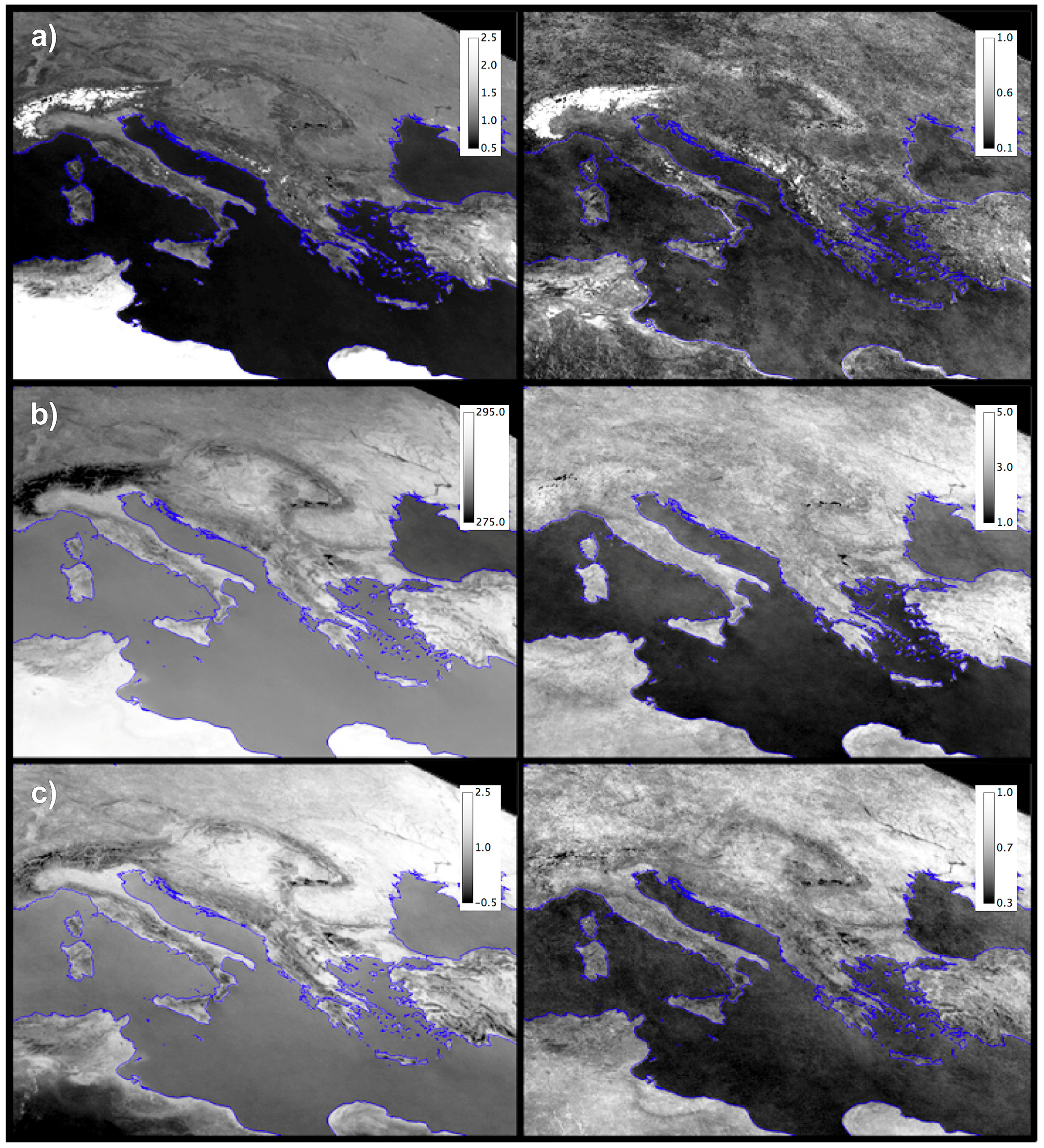





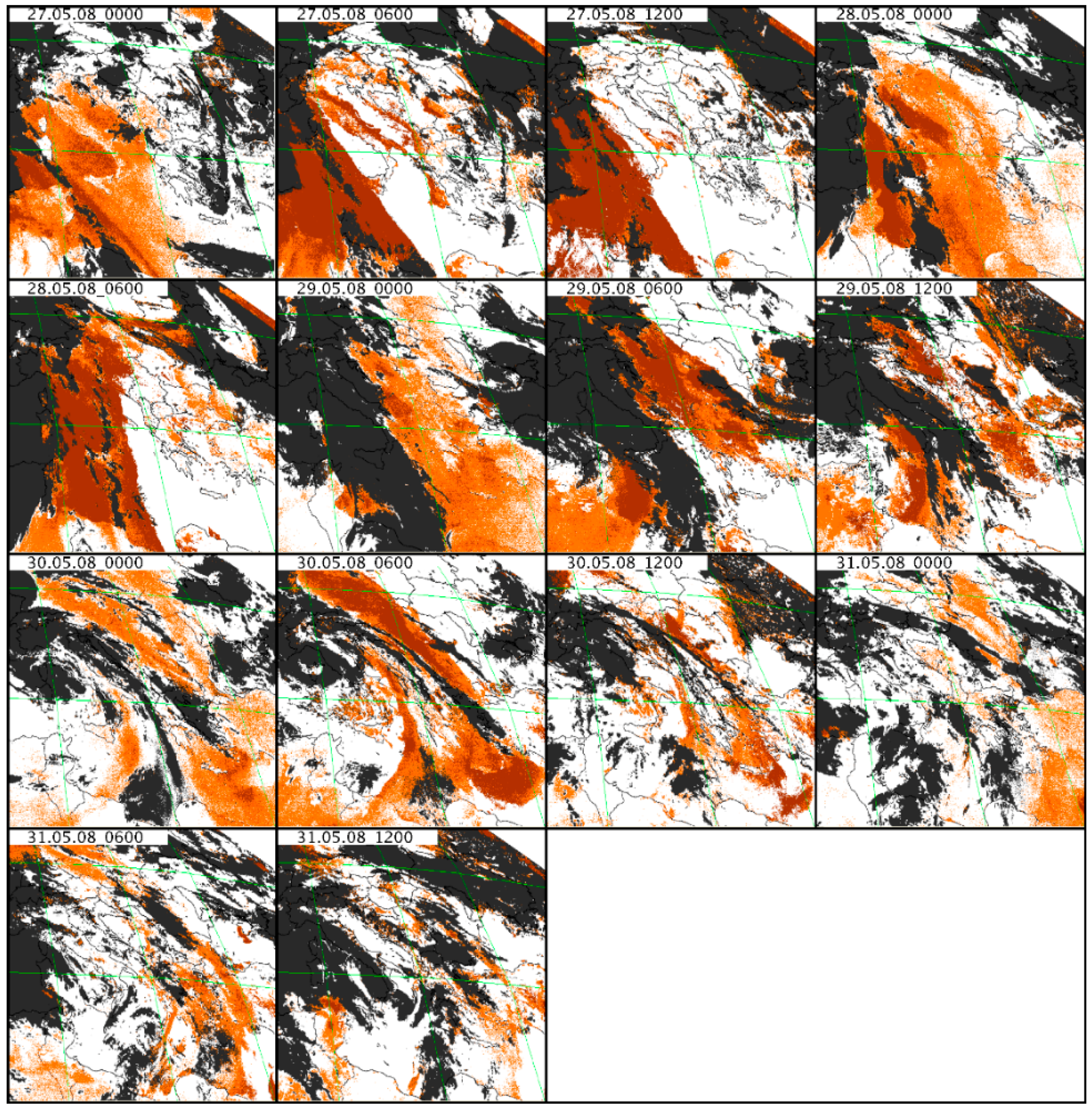
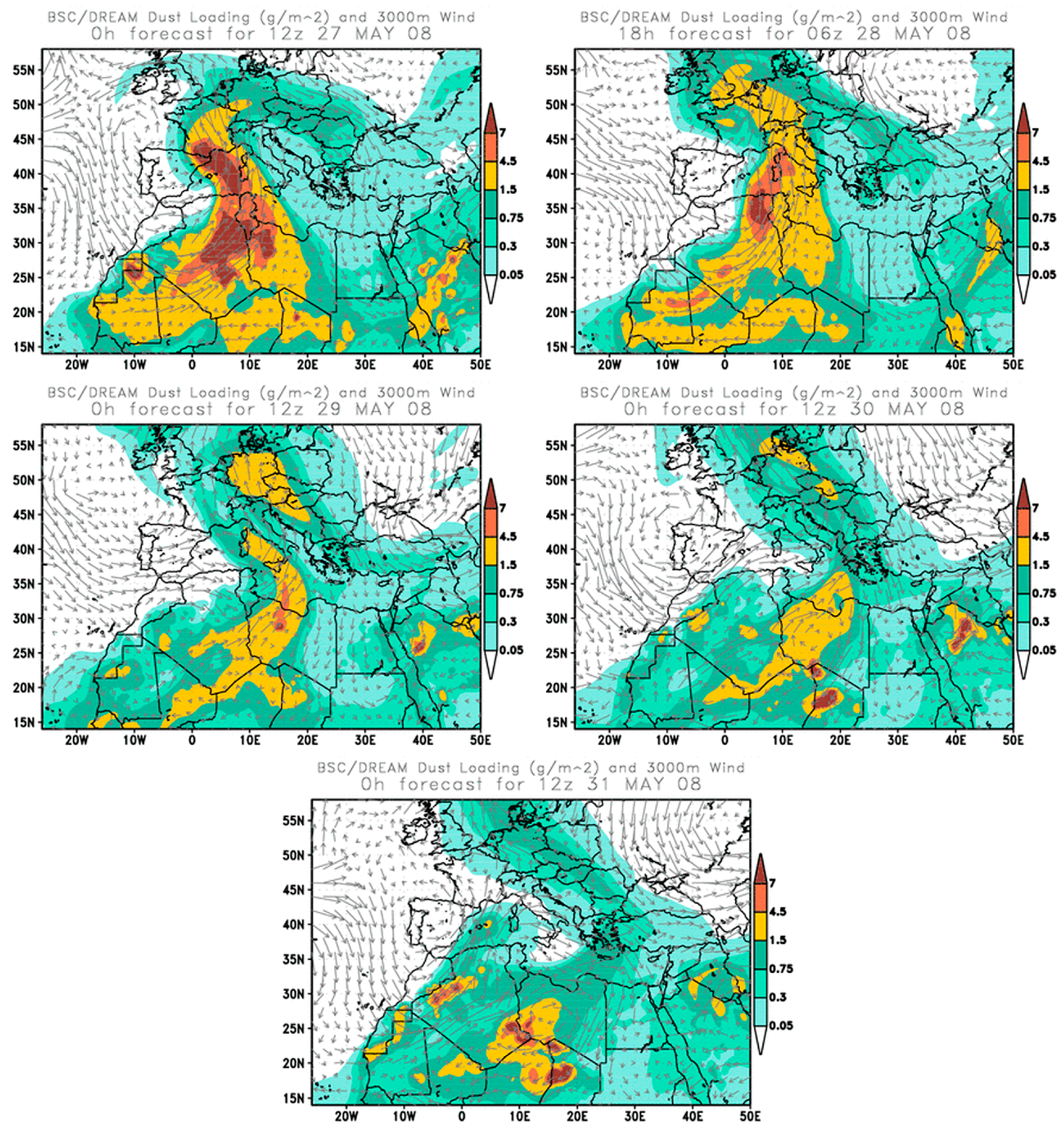


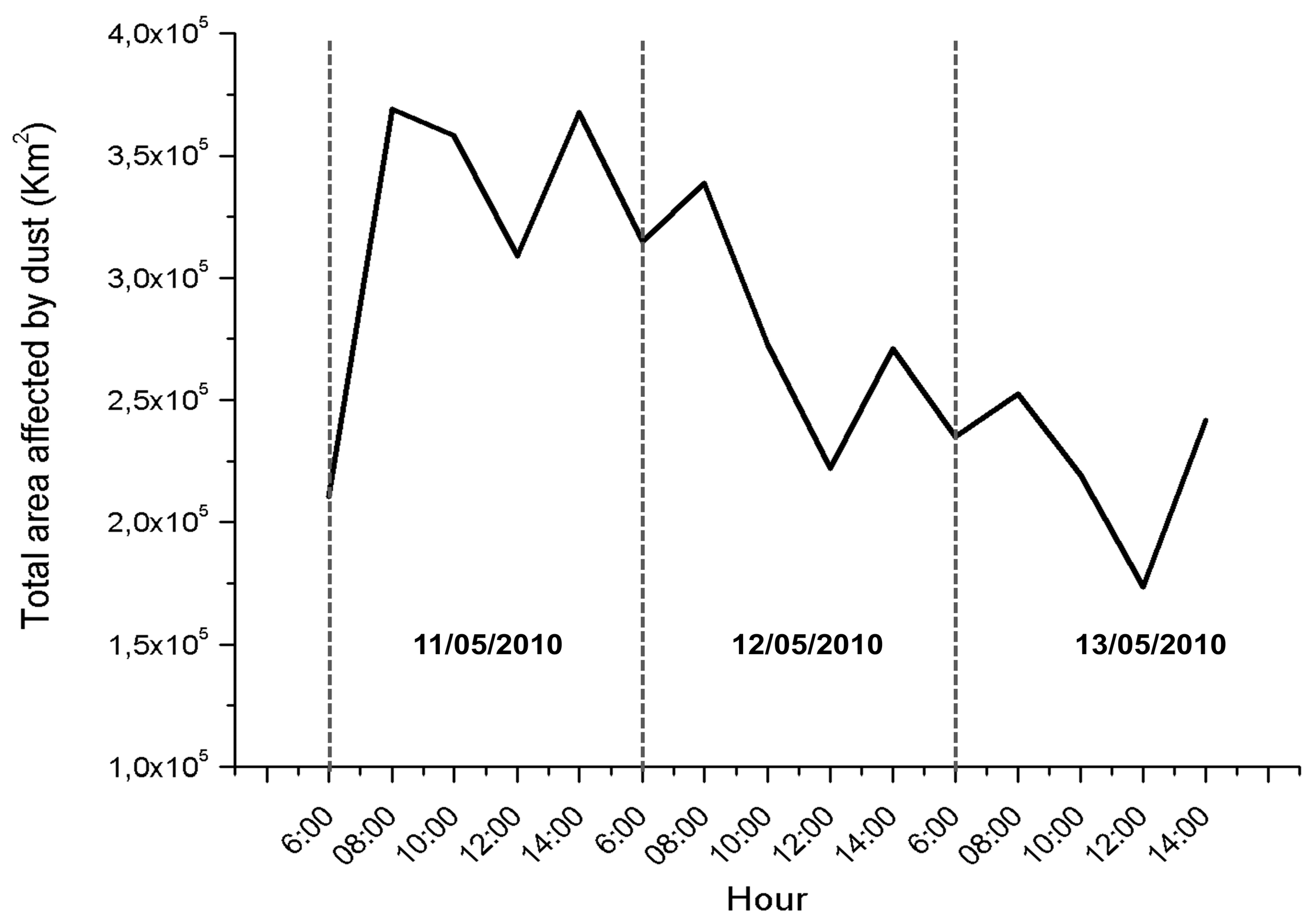
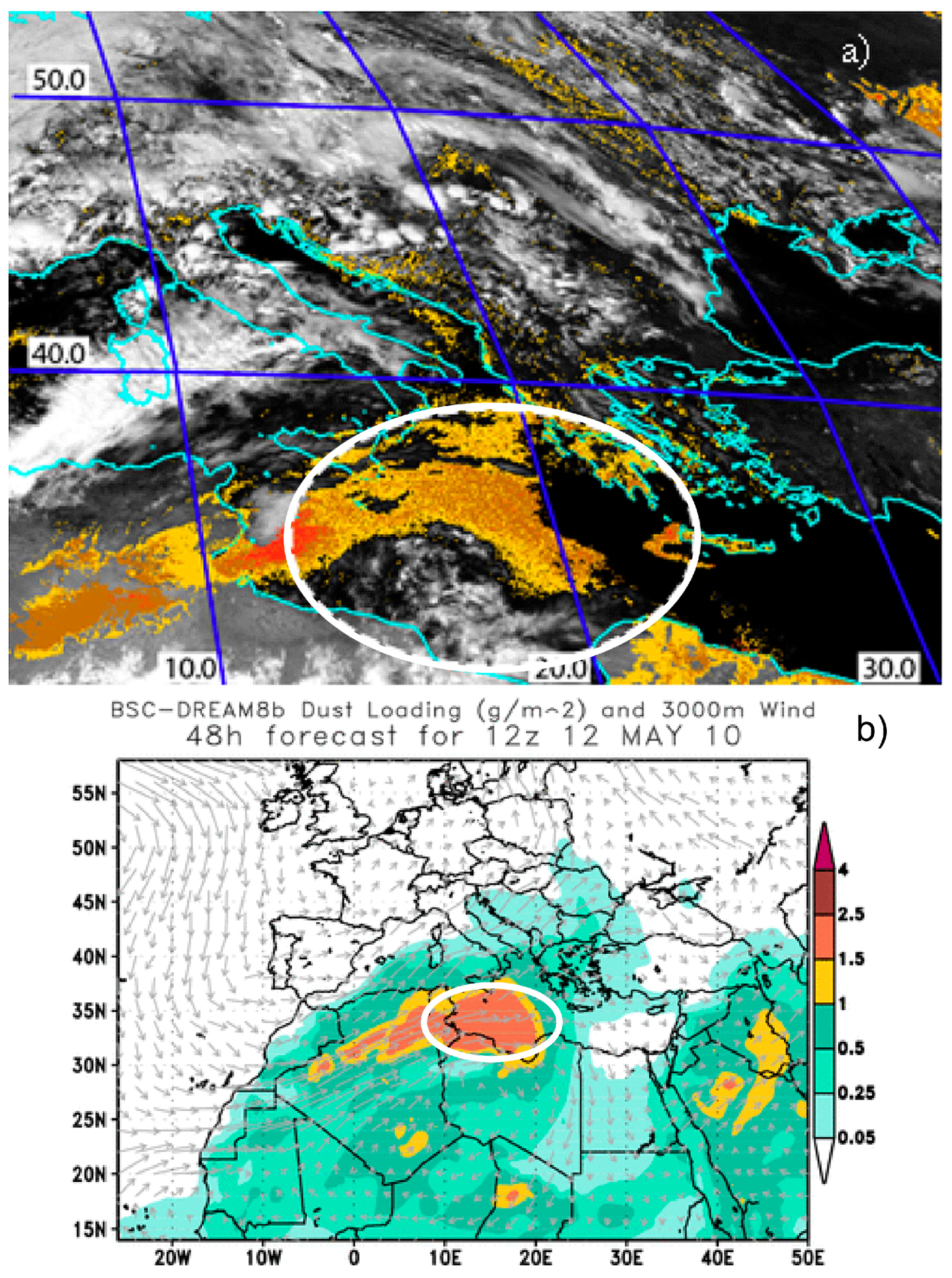
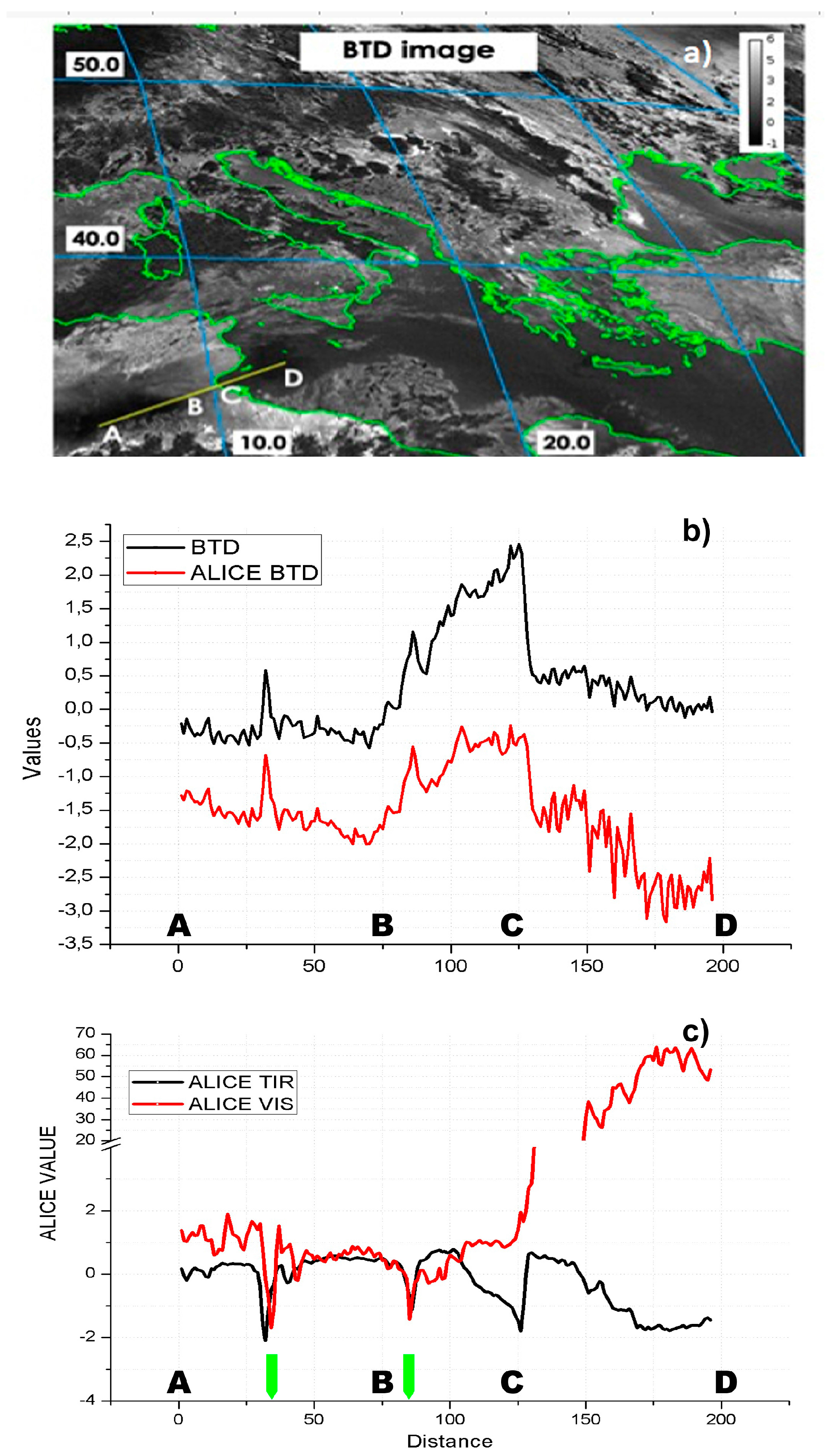
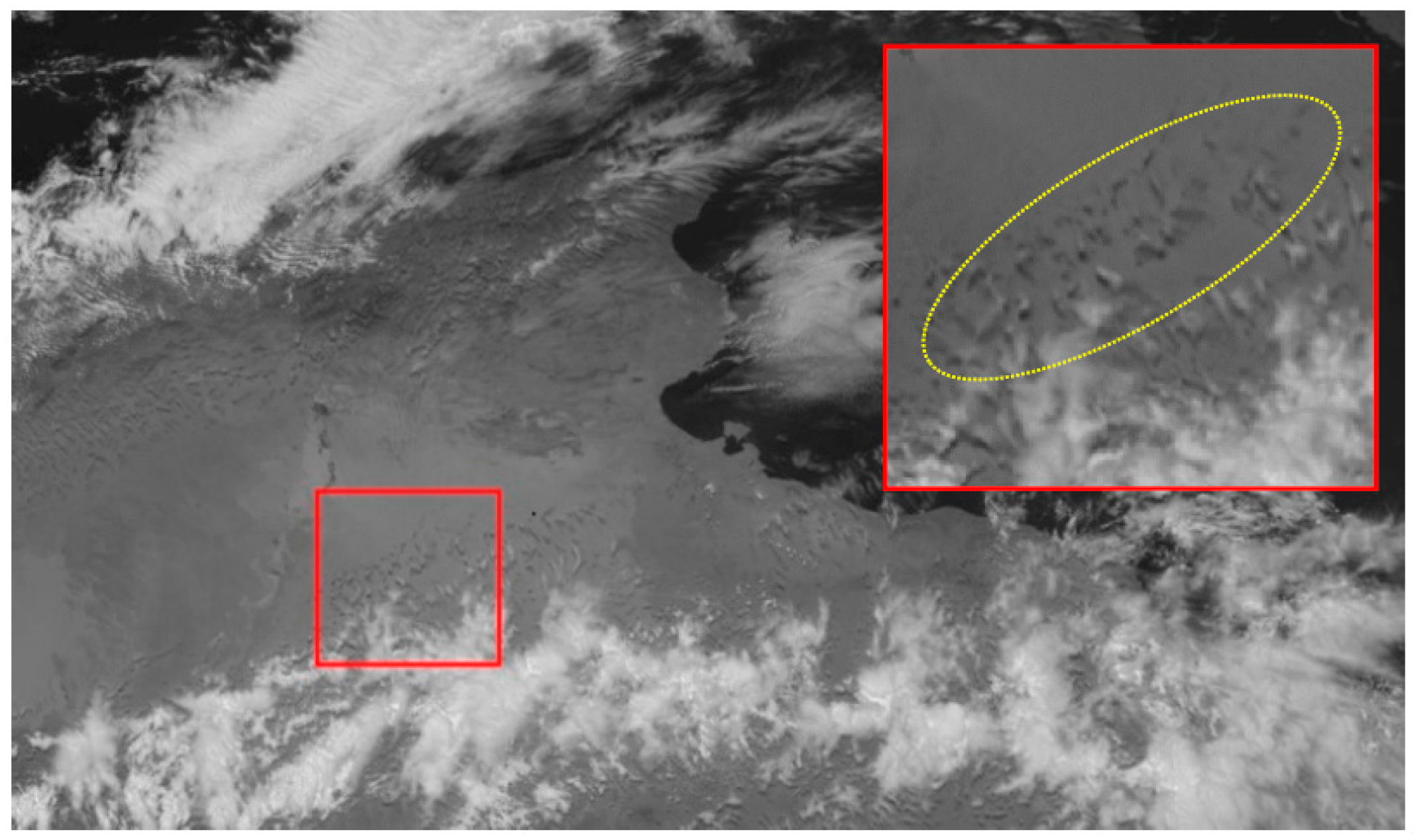
© 2017 by the authors. Licensee MDPI, Basel, Switzerland. This article is an open access article distributed under the terms and conditions of the Creative Commons Attribution (CC BY) license (http://creativecommons.org/licenses/by/4.0/).
Share and Cite
Marchese, F.; Sannazzaro, F.; Falconieri, A.; Filizzola, C.; Pergola, N.; Tramutoli, V. An Enhanced Satellite-Based Algorithm for Detecting and Tracking Dust Outbreaks by Means of SEVIRI Data. Remote Sens. 2017, 9, 537. https://doi.org/10.3390/rs9060537
Marchese F, Sannazzaro F, Falconieri A, Filizzola C, Pergola N, Tramutoli V. An Enhanced Satellite-Based Algorithm for Detecting and Tracking Dust Outbreaks by Means of SEVIRI Data. Remote Sensing. 2017; 9(6):537. https://doi.org/10.3390/rs9060537
Chicago/Turabian StyleMarchese, Francesco, Filomena Sannazzaro, Alfredo Falconieri, Carolina Filizzola, Nicola Pergola, and Valerio Tramutoli. 2017. "An Enhanced Satellite-Based Algorithm for Detecting and Tracking Dust Outbreaks by Means of SEVIRI Data" Remote Sensing 9, no. 6: 537. https://doi.org/10.3390/rs9060537
APA StyleMarchese, F., Sannazzaro, F., Falconieri, A., Filizzola, C., Pergola, N., & Tramutoli, V. (2017). An Enhanced Satellite-Based Algorithm for Detecting and Tracking Dust Outbreaks by Means of SEVIRI Data. Remote Sensing, 9(6), 537. https://doi.org/10.3390/rs9060537







